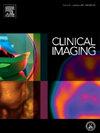Optimizing contrast-enhanced abdominal MRI: A comparative study of deep learning and standard VIBE techniques
IF 1.5
4区 医学
Q3 RADIOLOGY, NUCLEAR MEDICINE & MEDICAL IMAGING
引用次数: 0
Abstract
Objective
To validate a deep learning (DL) reconstruction technique for faster post-contrast enhanced coronal Volume Interpolated Breath-hold Examination (VIBE) sequences and assess its image quality compared to conventionally acquired coronal VIBE sequences.
Methods
This prospective study included 151 patients undergoing clinically indicated upper abdominal MRI acquired on 3 T scanners. Two coronal T1 fat-suppressed VIBE sequences were acquired: a DL-reconstructed sequence (VIBEDL) and a standard sequence (VIBESD). Three radiologists independently evaluated six image quality parameters: overall image quality, perceived signal-to-noise ratio, severity of artifacts, liver edge sharpness, liver vessel sharpness, and lesion conspicuity, using a 4-point Likert scale. Inter-reader agreement was assessed using Gwet's AC2. Ordinal mixed-effects regression models were used to compare VIBEDL and VIBESD.
Results
Acquisition times were 10.2 s for VIBEDL compared to 22.3 s for VIBESD. VIBEDL demonstrated superior overall image quality (OR 1.95, 95 % CI: 1.44–2.65, p < 0.001), reduced image noise (OR 3.02, 95 % CI: 2.26–4.05, p < 0.001), enhanced liver edge sharpness (OR 3.68, 95 % CI: 2.63–5.15, p < 0.001), improved liver vessel sharpness (OR 4.43, 95 % CI: 3.13–6.27, p < 0.001), and better lesion conspicuity (OR 9.03, 95 % CI: 6.34–12.85, p < 0.001) compared to VIBESD. However, VIBEDL showed increased severity of peripheral artifacts (OR 0.13, p < 0.001). VIBEDL detected 137/138 (99.3 %) focal liver lesions, while VIBESD detected 131/138 (94.9 %). Inter-reader agreement ranged from good to very good for both sequences.
Conclusion
The DL-reconstructed VIBE sequence significantly outperformed the standard breath-hold VIBE in image quality and lesion detection, while reducing acquisition time. This technique shows promise for enhancing the diagnostic capabilities of contrast-enhanced abdominal MRI.
优化对比增强腹部MRI:深度学习和标准VIBE技术的比较研究
目的验证一种深度学习(DL)重建技术,用于快速增强冠状面容积内插憋气检查(VIBE)序列,并与常规获取的冠状面VIBE序列进行比较,评估其图像质量。方法本前瞻性研究纳入151例经临床指示的上腹部MRI扫描的患者。获得了两个冠状T1脂肪抑制VIBE序列:dl重建序列(VIBEDL)和标准序列(VIBESD)。三位放射科医生独立评估了六个图像质量参数:整体图像质量、感知信噪比、伪影严重程度、肝边缘清晰度、肝血管清晰度和病变显著性,使用4点李克特量表。使用Gwet的AC2评估读者间协议。采用有序混合效应回归模型对VIBEDL和VIBESD进行比较。结果VIBEDL的采集时间为10.2 s,而VIBESD为22.3 s。VIBEDL表现出卓越的整体图像质量(OR 1.95, 95% CI: 1.44-2.65, p <;0.001),降低了图像噪声(OR 3.02, 95% CI: 2.26-4.05, p <;0.001),肝边缘清晰度增强(OR 3.68, 95% CI: 2.63-5.15, p <;0.001),肝血管清晰度提高(OR 4.43, 95% CI: 3.13-6.27, p <;0.001)和更好的病变显著性(OR 9.03, 95% CI: 6.34-12.85, p <;0.001),与VIBESD相比。然而,VIBEDL显示外周伪影的严重程度增加(OR 0.13, p <;0.001)。VIBEDL检出率为137/138 (99.3%),VIBESD检出率为131/138(94.9%)。两个序列之间的一致性从好到非常好不等。结论dl重建的VIBE序列在图像质量和病灶检测方面明显优于标准的憋气VIBE序列,同时减少了采集时间。这项技术有望提高腹部磁共振造影的诊断能力。
本文章由计算机程序翻译,如有差异,请以英文原文为准。
求助全文
约1分钟内获得全文
求助全文
来源期刊

Clinical Imaging
医学-核医学
CiteScore
4.60
自引率
0.00%
发文量
265
审稿时长
35 days
期刊介绍:
The mission of Clinical Imaging is to publish, in a timely manner, the very best radiology research from the United States and around the world with special attention to the impact of medical imaging on patient care. The journal''s publications cover all imaging modalities, radiology issues related to patients, policy and practice improvements, and clinically-oriented imaging physics and informatics. The journal is a valuable resource for practicing radiologists, radiologists-in-training and other clinicians with an interest in imaging. Papers are carefully peer-reviewed and selected by our experienced subject editors who are leading experts spanning the range of imaging sub-specialties, which include:
-Body Imaging-
Breast Imaging-
Cardiothoracic Imaging-
Imaging Physics and Informatics-
Molecular Imaging and Nuclear Medicine-
Musculoskeletal and Emergency Imaging-
Neuroradiology-
Practice, Policy & Education-
Pediatric Imaging-
Vascular and Interventional Radiology
 求助内容:
求助内容: 应助结果提醒方式:
应助结果提醒方式:


